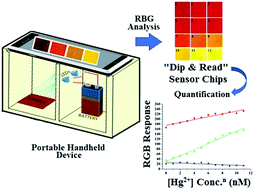Colorimetric detection and ratiometric quantification of mercury(ii) using azophenol dye: ‘dip & read’ based handheld prototype device development†
Abstract
The extreme toxicity of mercury and its derivatives results from its high affinity for thiol groups in proteins and enzymes, leading to the dysfunction of cells and consequent health problems. Thus, developing a rapid, cheap and colorimetric sensor for detecting mercury ions at very low levels remains a challenge. Herein, we have developed a new chromogenic azophenol-based probe which allows the colorimetric detection of Hg(II) metal ions and subsequently, showed suitability as a RGB chemodosimeter for the selective sensing of Hg(II) in aqueous medium. The UV-vis absorption and colorimetric study showed that the azophenol-based sensor is highly selective towards Hg(II) detection without the interference of other analytes. The color change from deep red to yellow in the complex solution after treating with mercury metal ions, which is visible by the naked-eye, makes this probe more convenient and simple to use in real sample analysis. Furthermore, for practical application of the sensor system in real time sample analysis, solid state silica based sensor chips have been developed which are impregnated with probe 1 displaying colorimetric changes for different concentrations of Hg2+, where the intensity of the red color decreased gradually towards a yellow color after the addition of Hg2+, apparently, makes them as potential candidate to conveniently monitor the concentration of Hg2+ in aqueous test solutions.



 Please wait while we load your content...
Please wait while we load your content...